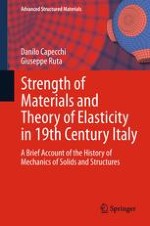This book examines the theoretical foundations underpinning the field of strength of materials/theory of elasticity, beginning from the origins of the modern theory of elasticity. While the focus is on the advances made within Italy during the nineteenth century, these achievements are framed within the overall European context. The vital contributions of Italian mathematicians, mathematical physicists and engineers in respect of the theory of elasticity, continuum mechanics, structural mechanics, the principle of least work and graphical methods in engineering are carefully explained and discussed. The book represents a work of historical research that primarily comprises original contributions and summaries of work published in journals. It is directed at those graduates in engineering, but also in architecture, who wish to achieve a more global and critical view of the discipline and will also be invaluable for all scholars of the history of mechanics.
